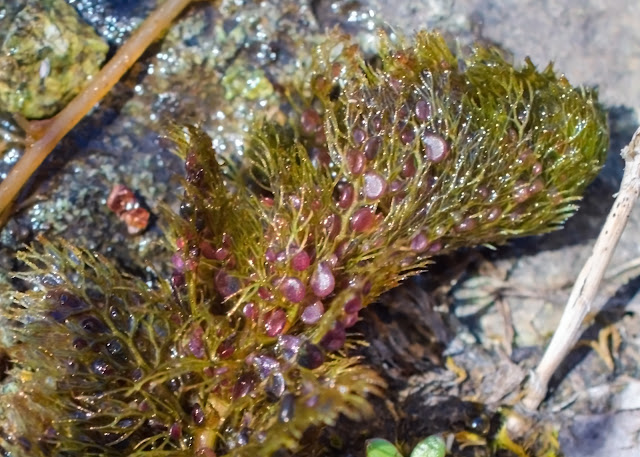So. I was wrong. I identified those yellow flowers as Utricularia intermedia, the Flat-leaved Bladderwort. It turns out they were the Common Bladderwort, U. macrorhiza. And I got an explanation of why.
This is why I love places like iNaturalist!
Anyhoo (not a typo), I had gone back, for the third time, to look at the plant. And this time, I brought a grabber tool to collect some of the underwater leaves. I took photos, then brought the leaves home to look at the bladders under the hobby microscope. And posted the photos to iNaturalist. Here.
So here are some of those photos; look at all the bug-eating bladders!
 |
| One long stem, on the path by the pond. Narrow leaves, black bladders everywhere. |
 |
| Tip of the branch. Where the sunlight is brightest, the bladders look pink. |
 |
| As seen under the microscope. Each bladder is attached to the stem with a short stalk. |
 |
| In among the leaves. This defines the plant as U. macrorhiza. |
 |
| A couple of bladders. |
Again; these are critter traps.
Tiny hairlike projections at the opening of the bladder are sensitive to the motion of passing organisms like Daphnia (water fleas). When they are stimulated, these hairs cause the flattened bladder to suddenly inflate, sucking in water and the passing animal and closing a trap door after it. (Botanical Society of A.)
 |
| The leaf-like tail extensions function like gills. About 1 cm. long. |
So now they're sitting in a bowl with the leaves and the mud and all. The caddisfly larvae are busy eating, but I haven't been able to get their photo.
Bueno. Me equivoqué. Esas flores amarillas, las identifiqué como Utricularia intermedia, y resulta que eran U. macrorhiza la utricularia común. Y me explicaron el porque.
¡Por esto es que me gustan sitios como iNaturalist!
Pues, había regresado por tercera vez a examinar la planta carnívora. Y esta vez, traje una herramienta que sirve para recoger cosas fuera del alcance de la mano para poder recoger algunas de las hojas subacuáticas. Saqué unas fotos y luego traje las hojas a casa para mirar las vejigas bajo mi microscopio. Subí las fotos a iNaturalist. Aquí.
Y esas hojas llevan cientos de vejigas.
- Un tallo lleno de hojas, en las piedras al la orilla de la laguna. Totalmente lleno de vejigas, también.
- El extremo del tallo. Donde le pega el sol con fuerza, las vejigas se ven color de rosa. Con un poquito menos de luz, se ven negras.
- Vistas las hojas bajo el microscopio. Cada vejiga se une a la rama con un tallo corto.
- Las vejigas se distribuyen entre las hojas. Esto es una de las características que define la planta como U. macrorhiza.
- Dos vejigas.
Proyecciones miniaturas, parecidas a pelos, en la apertura de la vejiga sienten el movimiento de organismos tales como las Daphnia (pulgas acuáticas). Cuando se estimulan estos pelos, hacen que la vejiga, hasta entonces delgada, se infle, succionando el agua y con ella, el animalito, y cerrando la puerta atrás. (Botanical Society of A.)

No comments:
Post a Comment
I'm having to moderate all comments because Blogger seems to have a problem notifying me. Sorry about that. I will review them several times daily, though, until this issue is fixed.
Also, I have word verification on, because I found out that not only do I get spam without it, but it gets passed on to anyone commenting in that thread. Not cool!